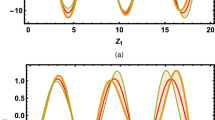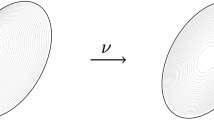Abstract
The paper considers the statement of the problem on quasi-stationary diagnosis of currents, temperature, salinity, and density fields for multiply connected areas with fluid boundaries. The principles of self-similar parameterization over the vertical axis are applied by introducing models for the vertical substance distribution, which have two regularly varying functions. The problem is reduced to handling a set of Poisson equations, enabling the boundary conditions to be automatically determined at the island shores. A scheme is presented for calculating current velocity components at an arbitrarily oriented transect. Several examples of current velocity computation for the topographically complex oceanic areas are given which support the data collectedin situ.
Similar content being viewed by others
References
Fomin, L. M.Theoretical Fundamentals of the Dynamic Method and its Application in Oceanography. Moscow: Izd. Akad. Nauk SSSR (1961).
Zyryakov, V. N.Theory for Stabilized Sea Currents. Leningrad: Gidrometeoizdat (1985).
Kamenkovich, V. M. About the integration of equations from the theory of sea currents in multiply connected areas.Dokl. Akad Nauk SSSR (1961)138, 1076–1079.
Demin, Yu. L. and Ibraev, R. A. Ocean dynamics models. In:Numerical Models and Calibration Calculations of Atlantic Ocean Currents. Moscow: Nauka (1992), pp. 42–95.
Vasilyev, A. S. Automodelling principles of the second kind in the monitoring of basic physical fields of the ocean.Dokl. Akad Nauk SSSR (1993)328, 613–618.
Vasilyev, A. S. Application of self-similar parameterization of thermohaline fields to marine ecological research.Phys. Oceanogr. (1995)6, 95–108.
Vasilyev, A. S. About the application of models for seawater density, temperature and salinity in theory for oceanic currents. In:Theory for Wind-Induced and Thermohaline Flows. Sevastopol: MHI (1968), pp. 168–181.
Vasilyev, A. S.Fundamentals of Applied Ecology of the Ocean. Vladivostok: Dalnauka (1992).
Samarsky, A. V.Introduction to Theory of Difference Schemes. Moscow: Nauka (1971).
Marchuk, G. I.Solving Numerically Problems of Air—Sea Dynamics Using Splitting Technique. Leningrad: Gidrometeoizdat (1974).
Vasilyev, A. S.Self-Educating Models for Biophysical Systems of the Sea. Sevastopol (1984) (Preprint, MHI, NASU).
Vasilyev, A. S. About the structure of the Antarctic circumpolar current at 20°E. In:Multidisciplinary Research in the Indian Ocean. Nelepo, B. A. (Ed.). Sevastopol: MHI (1977), pp. 100–119.
Additional information
Translated by Vladimir A. Puchkin.
Rights and permissions
About this article
Cite this article
Vasilyev, A.S. On the theory of calculation of currents in the world's ocean straits. Phys. Oceanogr. 7, 445–454 (1996). https://doi.org/10.1007/BF02509658
Issue Date:
DOI: https://doi.org/10.1007/BF02509658




